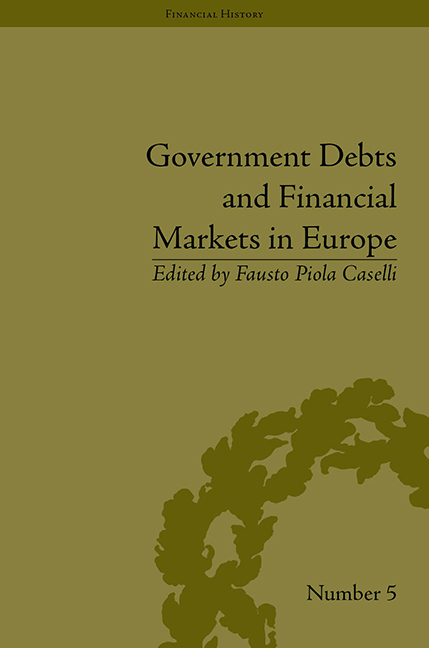Book contents
- Frontmatter
- CONTENTS
- Contributors
- List of Charts and Tables
- Introduction
- 1 The Financial Administration of North Hanseatic Cities in the Late Middle Ages: Development, Organization and Politics
- 2 Government Debts and Credit Markets in Renaissance Italy
- 3 Government Debts and Financial Markets in Castile between the Fifteenth and Sixteenth Centuries
- 4 Government Debt and Financial Markets: Exploring Pro-Cycle Effects in Northern Italy during the Sixteenth and the Seventeenth Centuries
- 5 Government Policies and the Development of Financial Markets: The Case of Madrid in the Seventeenth Century
- 6 The Role Played by Short-Term Credit in the Spanish Monarchy's Finances
- 7 From Subordination to Autonomy: Public Debt Policies and the Creation of a Self-Ruled Financial Market in the Kingdom of Naples in the Long Run (1500–1800)
- 8 Public Debt in the Papal States: Financial Market and Government Strategies in the Long Run (Seventeenth–Nineteenth Centuries)
- 9 Towards a New Public Credit Policy in Eighteenth-Century Spain: the Introduction of the Tesorería Mayor de Guerra (1703–6)
- 10 French Public Finance between 1683 and 1726
- 11 Long-Term War Loans and Market Expectations in England, 1743–50
- 12 Mercantilist Institutions for the Pursuit of Power with Profit: The Management of Britain's National Debt, 1756–1815
- 13 Italian Government Debt Sustainability in the Long Run, 1861–2000
- 14 Times of Wasteful Abundance: The Apogee of the Fiscal State in the Federal Republic of Germany from the 1960s to the 1980s
- Conclusion: Final Remarks
- Notes
- Bibliography
- Index
7 - From Subordination to Autonomy: Public Debt Policies and the Creation of a Self-Ruled Financial Market in the Kingdom of Naples in the Long Run (1500–1800)
- Frontmatter
- CONTENTS
- Contributors
- List of Charts and Tables
- Introduction
- 1 The Financial Administration of North Hanseatic Cities in the Late Middle Ages: Development, Organization and Politics
- 2 Government Debts and Credit Markets in Renaissance Italy
- 3 Government Debts and Financial Markets in Castile between the Fifteenth and Sixteenth Centuries
- 4 Government Debt and Financial Markets: Exploring Pro-Cycle Effects in Northern Italy during the Sixteenth and the Seventeenth Centuries
- 5 Government Policies and the Development of Financial Markets: The Case of Madrid in the Seventeenth Century
- 6 The Role Played by Short-Term Credit in the Spanish Monarchy's Finances
- 7 From Subordination to Autonomy: Public Debt Policies and the Creation of a Self-Ruled Financial Market in the Kingdom of Naples in the Long Run (1500–1800)
- 8 Public Debt in the Papal States: Financial Market and Government Strategies in the Long Run (Seventeenth–Nineteenth Centuries)
- 9 Towards a New Public Credit Policy in Eighteenth-Century Spain: the Introduction of the Tesorería Mayor de Guerra (1703–6)
- 10 French Public Finance between 1683 and 1726
- 11 Long-Term War Loans and Market Expectations in England, 1743–50
- 12 Mercantilist Institutions for the Pursuit of Power with Profit: The Management of Britain's National Debt, 1756–1815
- 13 Italian Government Debt Sustainability in the Long Run, 1861–2000
- 14 Times of Wasteful Abundance: The Apogee of the Fiscal State in the Federal Republic of Germany from the 1960s to the 1980s
- Conclusion: Final Remarks
- Notes
- Bibliography
- Index
Summary
In this paper I have tried to determine some essential points regarding the evolution of the Neapolitan public debt in the early modern age. In brief, these are:
1. The Kingdom of Naples had recourse to the public debt from the beginning of the early modern age, in line with the development of the public debt in the most economically dynamic areas of Europe;
2. Until the beginning of the eighteenth century, recourse to the public debt was closely connected to the political and financial demands of the Spanish monarchy of which Naples was part; at the same time, the public debt, especially that part ascribable to the communities, not only fed a flourishing domestic financial market, but was also an important point of contact and equilibrium between the classes that were most active economically and between these classes and the state;
3. The recovery of the Kingdom of Naples' political independence in the eighteenth century can be seen in the adoption of an independent financial policy regarding both the public debt and the regulation of the financial market;
4. The changes which took place during the eighteenth century, and especially from the beginning of the nineteenth century with the vast operation of consolidating the public debt during the decade of French rule, mark important moments in the modernization of the Neapolitan financial market, in its links with the network of big European finance and in the emergence of new operators.
In the Spanish Imperial System
The concept of the ‘Spanish Imperial’ system – a definition used more by early modern historians than by economic historians – embodies the idea that between the sixteenth and the eighteenth centuries a multiplicity of institutional, political, military, religious and economic-financial ties united the lands of the Spanish monarchy, surmounting its inherent differences and giving rise to a single body with a fair degree of cohesion. However, historians interpret this concept in very different ways, ranging from the classical interpretations of the polisinodiale monarchy by Jaime Vicens Vives and the composite monarchy by John Elliot to other more recent publications.
- Type
- Chapter
- Information
- Government Debts and Financial Markets in Europe , pp. 97 - 104Publisher: Pickering & ChattoFirst published in: 2014



